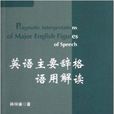《英語主要辭格語用解讀》從現代語用學的視角,運用現代語用學的理論和方法,對常用的16個英語主要修辭格進行了專題研究。全書共20章,第一章為“引言”,提出用語用學理論對傳統修辭格進行跨學科研究的可行性,簡要交代全書討論的主要內容。第二章分別對語用學和修辭學兩個學科的發展歷史和淵源進行了梳理,探索兩個學科的異同及可以進行交叉研究的領域。第三章介紹可用於解讀英語修辭格的主要語用學理論,提出全書研究的理論框架。第四章專門對英語修辭格進行概述,指出傳統英語修辭格的價值、分類及其傳統方法研究的不足。第五章到第十九章分別對16個英語辭格進行了詳細的語用解讀。第二十章為“結論”,分別總結幾種主要語用學理論對傳統英語辭格的解釋力,說明《英語主要辭格語用解讀》研究的不足之處,指出進一步研究的方向和領域。
基本介紹
- 書名:英語主要辭格語用解讀
- 作者:韓仲謙
- 出版日期:2013年3月1日
- 語種:簡體中文, 英語
- ISBN:9787118085952
- 外文名:Pragmatic Interpretations of Major English Figures of Speech
- 出版社:國防工業出版社
- 頁數:445頁
- 開本:32
- 品牌:國防工業出版社
內容簡介
圖書目錄
Chapter 2 Pragmatics and Rhetoric
2.1 Pragmatics
2.1.1 Origin and history
2.1.2 Definition
2.1.3 Areas of interests
2.1.4Criticism and defense
2.2 Rhetoric
2.2.1 Origin of rhetoric
2.2.2 Definition
2.2.3 Traditional rhetoric
2.2.4 Modern rhetoric
2.2.5 Interests of modern rhetoric
2.2.6 Elements of rhetoric
2.2.7 Rhetoric of or in a discourse
2.2.8 Purposes of figures of speech
2.3 Relationship between pragmatics and rhetoric
2.3.1 Prescriptive vs.descriptive and generation vs.interpretation
2.3.2 Kinds of discourse
2.3.3 Language use
2.3.4Conversation analysis and disposition
2.3.5 Questions under discussion?
2.3.6 Language production and invention
2.3.7 Intentions in communication
2.4 Summary
Chapter 3 Pragmatic Theories
3.1 Introduction
3.2 Deixis and presupposition
3.3 Speech act theory
3.3.1 Direct speech acts
3.3.2 Indirect speech acts
3.4 Conversational implicature
3.5 The cooperative principle (CP)
3.6 The politeness principle (PP)
3.7 Face and politeness strategies
3.8 The interest principle (IP)
3.9 The relevance theory (RT)
3.10 Summary
Chapter 4 Figures of Speech in English
4.1 Introduction
4.2 Examples and observations
4.3 Values of figures of speech
4.4 Types of figures of speech
4.5Conventional ways to the study of figure of speech and existing problems
4.6 Summary
Chapter 5 Allegory
5.1 Introduction
5.2 Definition of allegory
5.3Characteristics of allegory
5.4Categories of allegory
5.5 An illustration of allegory
5.6 Allegories as speech acts
5.6.1 Well-formedness of an allegory
5.6.2 Speech acts
5.7 Summary
Chapter 6 Analogy
6.1 Introduction
6.2 Definition of analogy
6.3 Features and functions of analogy
6.4 Examples of analogy
6.5 Relevance-theoretic interpretation of analogy
6.6 Analogy's pragmatic nature and cognitive schema
6.7Common forms of pragmatic analogy
6.8 Summary
Chapter 7 Antonomasia
7.1 Introduction
……

